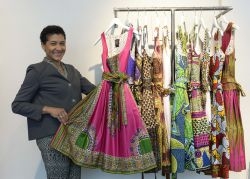Africa jazzes up Bavarian fashion for Oktoberfest

“We wanted to connect the cultures,” explained Rahmee Wetterich, 49, who together with her sister Marie Darouiche, 61, makes dirndls, the classic southern German dress of a low-cut blouse and a pleated smock, with a fresh African twist.
They call the creations, made with colourful fabrics familiar from the markets of the sisters’ native Cameroon, “Noh Nee”, which means “God’s gift” in Swahili.
Bavarian folklore goes hand-in-hand with the world’s biggest beer festival, complete with lederhosen suede short trousers for men, oompah music, thigh-slapping dances, and glass after sudsy glass of Germany’s amber nectar.
But as the event has grown more international, attracting tourists and expatriates from around the world, so have nearly two centuries of rituals and tradition.
During its 16-day run, around 6.4 million revellers will flock to the Wiesn fairgrounds to down nearly seven million litres of beer, and women in dirndls will be out in force.
– ‘The connection to Africa’ –
It was almost by chance that Wetterich and Darouiche embarked on their remarkable stylistic venture, a business idea that traces the journey of the two women who arrived in Bavaria more than 35 years ago.
Born in Cameroon, they came through Munich with family in the 1970s because one of their musician brothers was living there.
Life got in the way and they never made it to their intended final destination of France.
“My mother was a seamstress and we grew up among the fabrics — they were everywhere at home,” said Wetterich, an interior decorator by training.
“Marie has always loved cloth, including African scarves and wrappers. She learned sewing from my mother and it became her job. And she always kept in mind the connection to Africa, and these fabrics she loved.”
Soon their own children would be “immersed in the atmosphere of blended cultures and one day they said, ‘why don’t you make a dirndl?'” said Wetterich, who is married to a Bavarian, with a laugh.
The sisters made a prototype for an exhibition and admirers rushed to ask where they could get one of the signature frocks.
“Noh Nee” was born.
“We started in an office and then in the spring of 2011, we opened a store in the north of Munich, hidden in a courtyard. Then sometime this March or April, we moved to the very centre, on a very cool street,” Wetterich said.
The designers scrupulously respect the style codes of the dirndl, with its figure-flattering feminine design of a plunging neckline and cinched waist, which is often conveniently adjustable to accommodate beer consumption over the course of a day in an Oktoberfest tent.
“We consulted a specialised Bavarian seamstress to maintain the tradition — we wanted to go to the original and really get to know this culture,” Wetterich tells AFP.
For the fabrics, “Noh Nee” turned to African “classics, with patterns that sometimes date back 80 or 100 years”.
Beyond the vibrant colours, many are adorned with distinctive West African touches such as tiny white cowrie shells.
– A tradition refreshed –
This mix of expertise and cosmopolitan flair has met with great success, at a time when the dirndl has become trendy again among younger Bavarians.
“We have not changed the tradition but we refreshed it,” said Wetterich in lightly accented German.
Simone Egger of the Institute of Folklore and European Ethnology at Munich University said it was this adaptability that gave the dirndl its staying power.
“The basic cut can always be reinterpreted, which may be one reason why it works so well — there’s something for everyone,” she said.
“At the same time, this ‘Dirndl a l’africaine’ reflects the diversity of our urban societies.”
Wetterich said her customers come from all walks of life — fashionistas, Africa lovers and those adverse to the conservative connotations of Bavarian “Tracht” festive attire who want to make a statement.
Last year, they made “a few hundred” dresses. Each one, whose price ranges from 500 to 1,100 euros ($650 to 1,425), is designed by Darouiche in her workshop, which employs up to five people at a time.
They are produced near Passau, close to the Austrian border.
Beyond their African roots, the dirndls have pedigree reflecting the sisters’ own multicultural heritage.
They both have French citizenship because their Syrian father joined the Foreign Legion and took the French nationality. He went to Cameroon with the force in the 1960s, where he met their mother.
As a nod to their French ties, the sisters often add lace petticoats under their dirndls’ skirts.
“Our customers love them,” Wetterich said.

